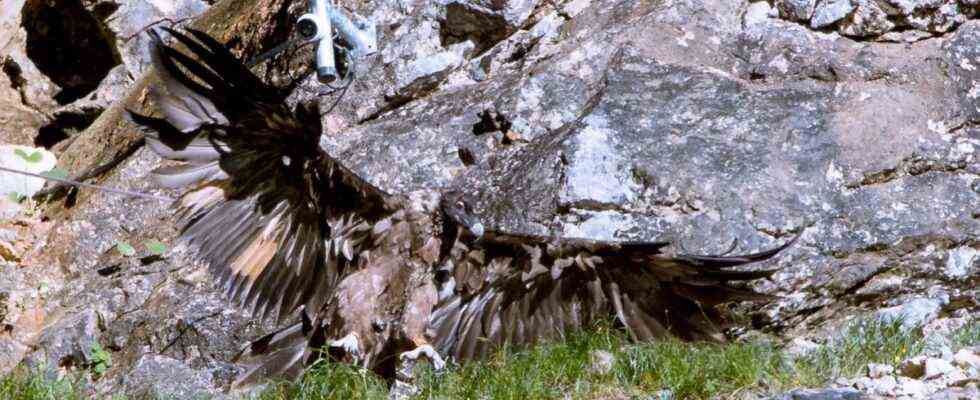As shaky as Bavaria’s maiden flight may have been, from the point of view of Norbert Schäffer, one cannot overestimate its importance. “When Bavaria took off on Thursday morning at 5:19 am in the release niche with a few powerful flaps of its wings, it became a bearded vulture in the wild from one second to the next,” says the biologist and chairman of the State Association for Bird Protection (LBV). “Up to that moment she was a breeding bird in human care. Now we have no more control over her. Bavaria’s maiden flight is a giant step for our reintroduction project.”
Bavaria is doing well in the new freedom. On their first night outside, violent thunderstorms with torrential rain raged over the Berchtesgaden National Park. But she survived it in stoic serenity – on a small ledge on the steep slope near the release niche on the Knittelhorn, in which the SZ female bearded vulture Wally was sitting in the dry. Bavaria was completely soaked on Friday morning. She first had to let her plumage dry before she could take off on new practice flights.
From the point of view of the LBV people, it is not surprising that Bavaria was the first to take off. Wally is the clearly more curious and agile of the two birds of prey. “But it has about ten centimeters less wingspan and is about a pound lighter than Bavaria,” says the head of the resettlement project, Toni Wegscheider. “She is also a little younger.” Bearded vultures usually take off for the first time at around 120 days. Bavaria was 119 days old on Thursday and therefore “early anyway”, as Wegscheider says. Wally was 116 days old on Thursday. “I’m happy for every day that Wally stays in the rock niche,” says Wegscheider. “Because with young bearded vultures, every day counts that they can devour themselves in the niche and that they can mainly use for training.” Exercising means that the birds of prey spread their wings and flap them vigorously – until they can flap their wings more than 200 times a day.
With Bavaria’s maiden flight, a bearded vulture is in the wild in Bavaria for the first time in several hundred years. Gypaetus barbatus, as the species is called in Latin, is one of the most powerful birds of prey in the world with a wingspan of 2.90 meters and was originally at home in the entire Alpine region. But the bearded vultures were hunted mercilessly, and by the beginning of the 20th century they were extinct. In the eighties the resettlement of the scavengers began – first in the Hohe Tauern, later on the Ortler and on the Mont Blanc. There are currently around 300 bearded vultures living in the Alps. The LBV’s reintroduction project is intended to help close the gap to the Balkans.
Now it’s exciting. Bavaria will take off incessantly for practice flights and will be a little more skillful with each new one. This is especially true for touching down on the floor. “These are now more or less violent crash landings,” says LBV boss Schäffer, who observed Bavaria all Thursday. Once she sailed fully into a bush, so that it shook all the branches and twigs wildly back and forth. Schäffer almost became a little worried that something had happened to her. You don’t have to worry. Young bearded vultures can withstand a lot. Also “somersaults on the first landings”, as Wegscheider puts it. In addition, there are no wire ropes in the air on the Knittelhorn, no lifts and no mighty trees that Bavaria could crash into. “And bushes, even very dense ones, are really not a risk,” says Wegscheider. On Thursday, Bavaria soon stomped out of the branches and climbed again over hill and dale for the next training flight.
Much more exciting is how long Wally will last in the release niche. Not only because she is getting fitter and also has reached the 120-day limit these days when the bearded vulture takes off. But because she observes very closely how Bavaria is doing in her new freedom. “Young bearded vultures orientate themselves closely to each other,” says Wegscheider, “if one discovers food, the other quickly trudges after it.” This is also the case with maiden flights. “If one of them is, it usually doesn’t last much longer for the other.”
And yet it will be different at Wally, and at Bavaria, Wegscheider is pretty sure of that. “Wally is methodical, purposeful,” he says, “in wing training she systemically made a few more strokes every day until she routinely passed the 200 limit at some point.” Bavaria, on the other hand, hit around 80 strokes one day, over 300 the next and almost none on the third. Bavaria’s maiden flight was as spontaneous as the wing training. “Nobody expected that she would stand up early in the morning, spread her wings and then be gone,” says Wegscheider. “Wally, on the other hand, will first find out where a good place to take off is.”

